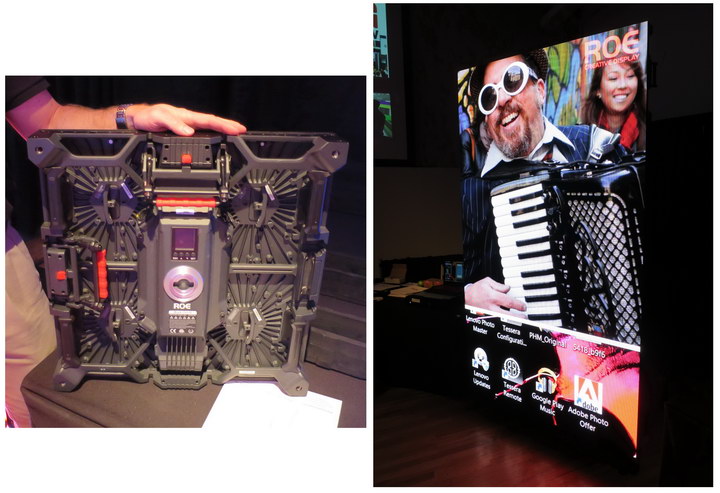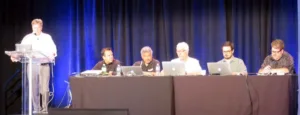On July 29th, the Rental and Staging Roadshow came to New York. The focus was on professional AV products as used by the rental and staging (R&S) industry.
Two panel discussions at the roadshow were of interest to readers of Large Display Monitor, the first on Media Servers for the R&S industry and the second on laser projectors for the industry. David Keene, Executive Editor of the Systems Group at NewBay Media, was host for the roadshow plus the moderator for both panels.
No significant new products were introduced at the Rental and Staging Roadshow. Mostly it was an educational experience for both the R&S workers in New York and for me.
Content and Media Server Issues for Live Event Production
Media server panelists included Kevin Zevchik of AV Stumpfl, Steve Gilbard of Theatrical Concepts, Lars Pederson of Worldstage, and two independent, award-winning Broadway and special event Video Designers, David Brodie, and Zachary Borovay.
Roadshow Media Server Panel. L. to R. David Keene (Standing), Kevin Zevchik, Steve Gilbard, Lars Pederson, David Brodie and Zachary Borovay
There are currently a variety of Media Servers available for live production. Servers from D3 Technologies, Pandora’s Box from CoolLux, Watchout and WorldStage’s Digital Media Hub were all discussed. In addition, software from Catalyst was described, which can be used on Apple Mac and turns them into media servers. Live tweets have become a significant part of live shows and Viz:140 software for managing and moderating this live Tweet stream was discussed.
One major issue with media servers is that they all have different capabilities and different software. Once a media server is chosen for a show, it is almost impossible to change to a different brand or even a different server from the same brand. Essentially, if you must switch because your original choice of servers turns out to not fit the application, you have to start over again essentially from scratch and rewrite your show control program. It goes without saying that this is an expensive and time wasting procedure.
For example, Borovay said he helped develop a long running Broadway show with Watchout 3 servers. Currently, Watchout 5 servers are state of the art, but there is no discussion of upgrading the servers. Pretty much the only time a Broadway, Las Vegas or other long running show will change servers is when the show leaves Broadway and goes on the road. In this case, the Pro AV portion of the show needs to be redeveloped anyway, since it needs to fit a variety of venues, not just a single theater.
A major show doesn’t just use a single media server. Big shows with complex effects, as are now common on Broadway, can use as many as 8 servers with up to 8 additional servers as backups. The backup servers can either be paired 1:1 with the primary servers, ready to be brought on-line instantly in case of a failure during a show, or run through a media switch matrix to allow fewer servers to act as backups and still allow each primary server to have multiple backups.
Media servers for live productions don’t just serve up video. The new generation media servers have features such as support for many live inputs, a real time Media Engine, a Media Manager/Encoder (to stream a show to IP, real time, to a remote location), 3D mapping and warping, live masking, and timeline based editing. Media, of course, includes not just video, but audio and still images as well. This media can be either live or from content created during show development. In addition to media, the servers can control systems such as curtains, moving stages, lights, etc.
Next Generation Video Projection: 4K, new Laser Phosphor Projectors for the Staging market, pure Laser projectors, and more
This panel session was again moderated by David Keene, with panelists Bill Beck from Barco, Jeff Schneider from Digital Projection, Mike Garrido of Christie, and a representative from Panasonic. The discussion focused on laser projectors and how the requirements for R&S differ for other applications for laser projectors such as digital cinema and other Pro AV applications such as conference rooms.
Lifetime of the laser projector light source was, perhaps, the key difference between R&S needs and other Pro AV applications. A R&S projector has a maximum life of about 5,000 hours before the R&S company replaces it in its inventory with a newer projector. This means they aren’t particularly interested in the lifetime of the lamp. If it is less than 5,000 hours, they can just charge the rental customer for it.
“Super Bright” is much more of an issue in a R&S projector, according to Barco’s Beck. This especially applies to projection mapping applications where they are using a building or other less-than-ideal object as the projection screen. Panasonic described a “rental mode” in their projectors that allowed the laser light source to be driven at higher power for higher output at the expense of lifetime.
 ROE Black Onyx LED display, which targets the R&S industry. Left: Module from rear. Right: 3 x 5 array.
ROE Black Onyx LED display, which targets the R&S industry. Left: Module from rear. Right: 3 x 5 array.
There was also a mini-trade show at the event, featuring projectors from a variety of vendors. Perhaps the most interesting thing to me was the LED video wall modules from ROE Creative Display that were specifically designed for the R&S market. First, the 20” square modules with a 3.4mm pitch were made out of special materials to make them lightweight and easy to handle. Second, they had magnetic latches that allowed them to be installed by only two people, one in front of the wall and one behind. After the supporting framework for the wall was assembled, the workmen would start installing the modules from the top down. Guide pins made sure the location was correct and the magnetic latch would allow a module to snap in place. Once it was correctly positioned, a positive mechanical lock would be activated by the person behind the wall to hold it there securely. Clever. – Matthew Brennesholtz

